THE LANCE MITAN SUSPENSION BRIDGE
Trinidad
|
From: The Living Islands Project THE LANCE MITAN SUSPENSION BRIDGE Trinidad |
|
Map - In the Newspapers
The Lance Mitan Suspension Bridge - Replacing the Lance Mitan Bridge
Damaged Boat - Damaged Flat Bridge
Why The Lance Mitan Suspension Bridge Failed
Without a sustained ‘Preventative Maintenance’ policy; corrosion caused collapse. The following picture shows the corrosion to the irreparable surviving upper main loadbearing cable. The broken cables would be in a similar condition. Continued application of suitable paint would have preserved the bridge.
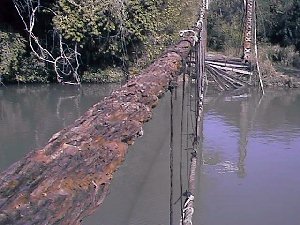 The inevitable collapse of the Lance Mitan suspension bridge after 99 years is a statement to clever and economic civil engineering defeated by shoddy maintenance.
The inevitable collapse of the Lance Mitan suspension bridge after 99 years is a statement to clever and economic civil engineering defeated by shoddy maintenance.
The reasons for the bridges construction in the first place, may be attributed to the agriculture of cocoa and other related produce that came from the estate at the ‘other side’ of the river. Remains of structural foundations and other not insignificant wall-works at the ‘beach’ indicate other economic activities which may have included fishing and the siting of a small port.
A down turn in the economy of the agricultural sector over the intervening years increased the vulnerability of the bridge. As time passed, the area in which the bridge is sited was perceived to be of less commercial significance and being geographically in the ‘far south’ was practically forgotten.
The inevitable neglect by an under funded Regional Corporation to maintain this bridge, has now led to the loss of a small treasure to the nation.
This is not the only bridge to have been lost in this area.
| What may have also been sadly lost, but for other reasons, is the Regional Corporations engineering ability to rebuild a suspension bridge. Any statement(4) that claimed that the bridge would have been in a state of repair in time for Augusts celebration of the 500th anniversary of the discovery of Trinidad by Columbus, which occurred within this region, would be totally fallacious. This is because the bridge has been beyond ‘safe’ repair for at least 15 years; chiefly due to the state of corrosion in the main suspension cables; the reason for the collapsed on Carnival Sunday. To have ‘repaired’ the bridge would have required ‘restringing’ the main cables. I have doubts that this was part of the ‘repair’ agenda. |
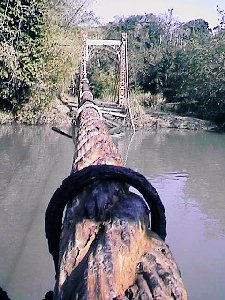 |
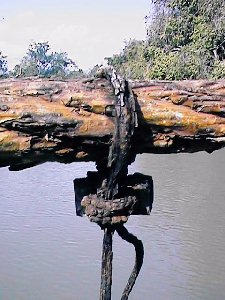 |
On the left is another view of the corroded upper main cable. Attached to it is what is left of probably one of the few original ‘stringers’; made from smaller gauge cable that, at suitable intervals, are strung to support the load of the lower cable. |
| On the right is an example of corrosion in the lower cable. Around it is the ‘ring’ of one of the newer type of ‘solid rod stringer’ that was used in maintenance of the bridge. Paint has preserved part of it - as it has some of the lower cable itself; but this ‘stringer’ has also failed due to corrosion along parts of its length. It now dangles its end in the water. | 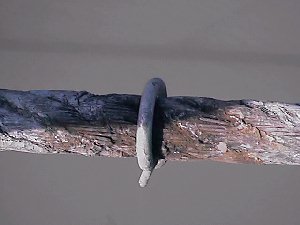 |
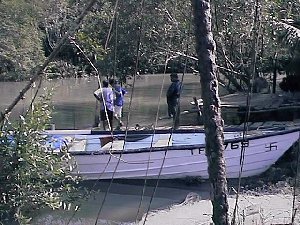 |
In the foreground of the picture of the damaged fishing boat is an example of corrosion to one of the ‘solid rod stringers’. Kinking, rather than curved bending, of the ‘solid rod stringers’ in the background, indicate points of corrosion. |
Maintenance of the bridge over the years has replaced the original ‘flooring’ of the bridge with ‘I’ beams that have been used to span the lower cables of the bridge. ‘I’ beams were not available to the original builders as they are a product of a continuous steel process that was not developed until after the turn of the century. Over these ‘I’ beams wooden planks were used to made up the floor of the bridge. The ‘I’ beams were held in place on the lower cable by ‘U’ bolts.
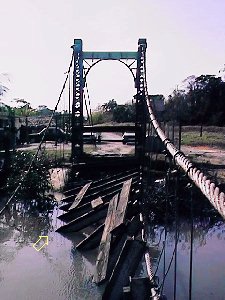 |
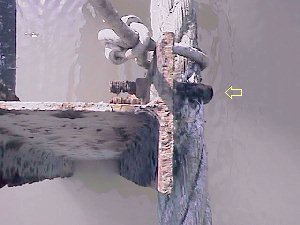 |
The pictures above show the general spacing of the ‘I’ beams as they made up the ‘floor’ and the position of the fixing ‘U’ bolts. The ‘U’ bolts show heavy corrosion.
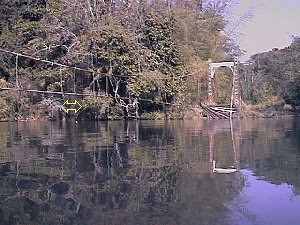 |
The surviving lower cable here shows where the ‘I’ beams ought to have hung after the opposite cable broke. They are absent because the corroded ‘U’ bolts snapped; dropping the beams to the bottom of the river. |
| Corrosion is shown on the dual solid ‘anchor’ rods that connect the main suspension cable to the ground foundations. The riveted wrought-iron structure of the ‘upright’ is shown in the background, onto which the old sign reading ‘NOTICE Bridge closed to vehicular traffic’ is fixed. The condition of the ‘upright’ structure was not examined in any detail for this ‘passing’ survey; so no comment on its condition is available here. |
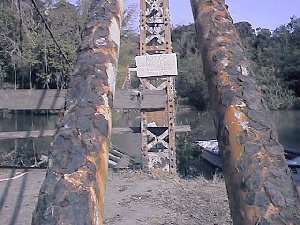 |
Map - In the Newspapers
The Lance Mitan Suspension Bridge - Replacing the Lance Mitan Bridge
Damaged Boat - Damaged Flat Bridge
Images: Digital CASIO QV-100 © 1998: tobagojo@trinidad.net
| The Living Islands Project © 1998: tobagojo@gmail.com - 980308 Last Update: 02 June 1998 00:00:00 Processed by: Jeremy G de Barry |
|
| http://www.seetobago.org/trinidad/sbridge/lmsb2.htm | © 1997: tobagojo@gmail.com - 19980308 - 1m20071228 - 2m20140615 Historic Update: 02 June 1998; Last Update: 20 June 2014 01:30:00 TT Processed by: Jeremy G de Barry |
|
| An historic web page for this site; one of the first set by The Living Islands Projects. The page is left mostly in its origional presentation format, apart from an external update to its active eMail link; and internal coding and 'METAS' that update its compatability, list its content and records its dating history. This footer is added for update compatibility. | ||